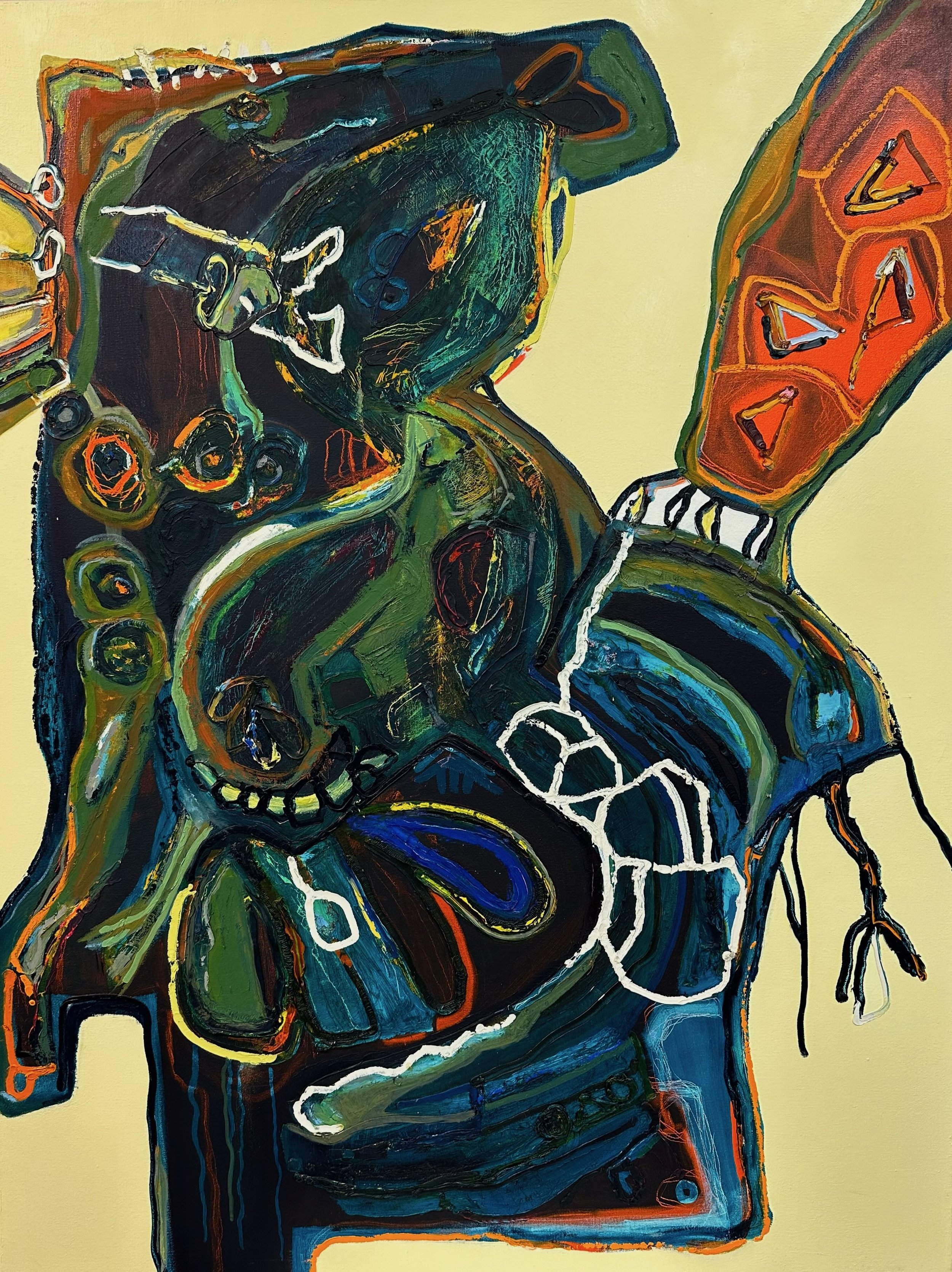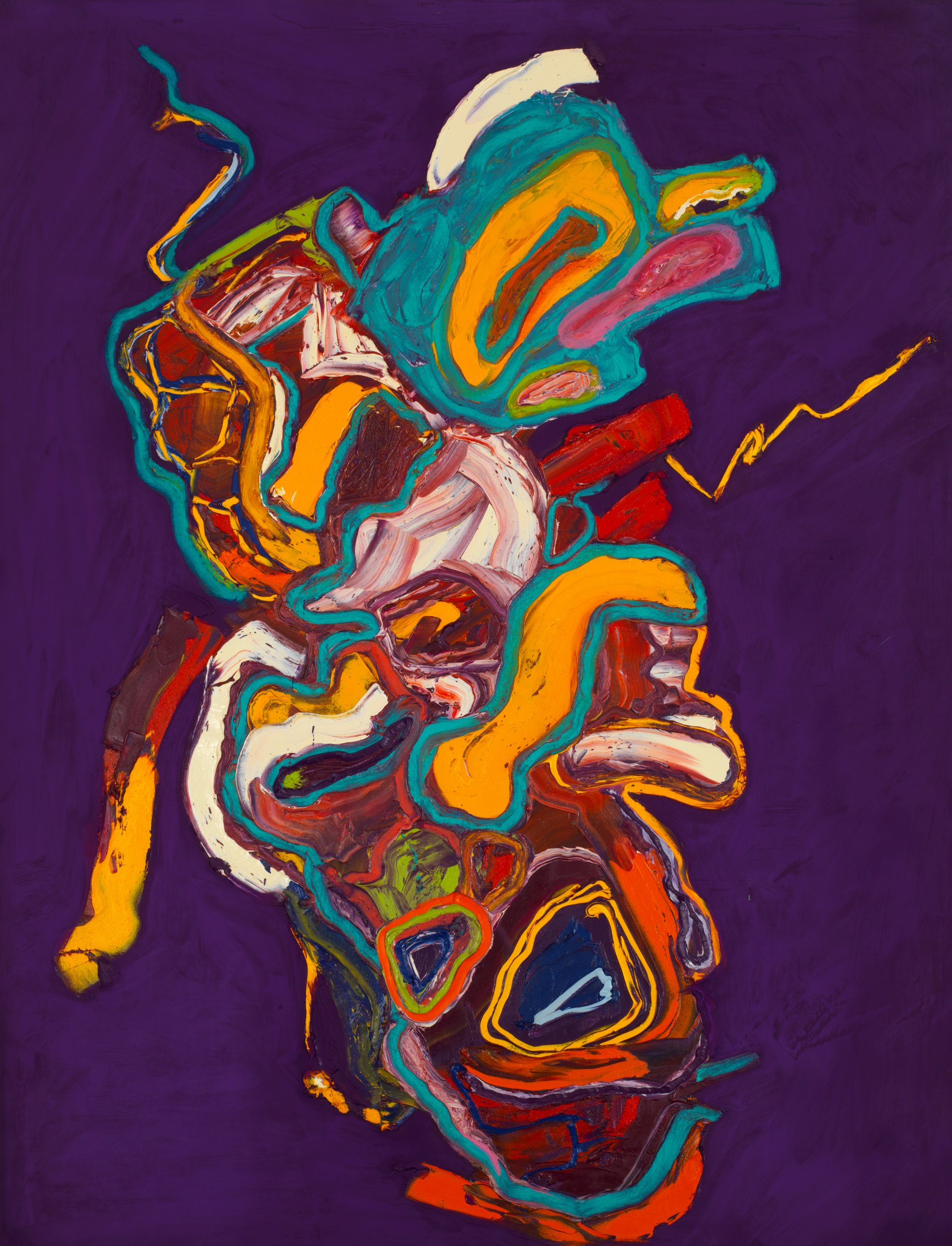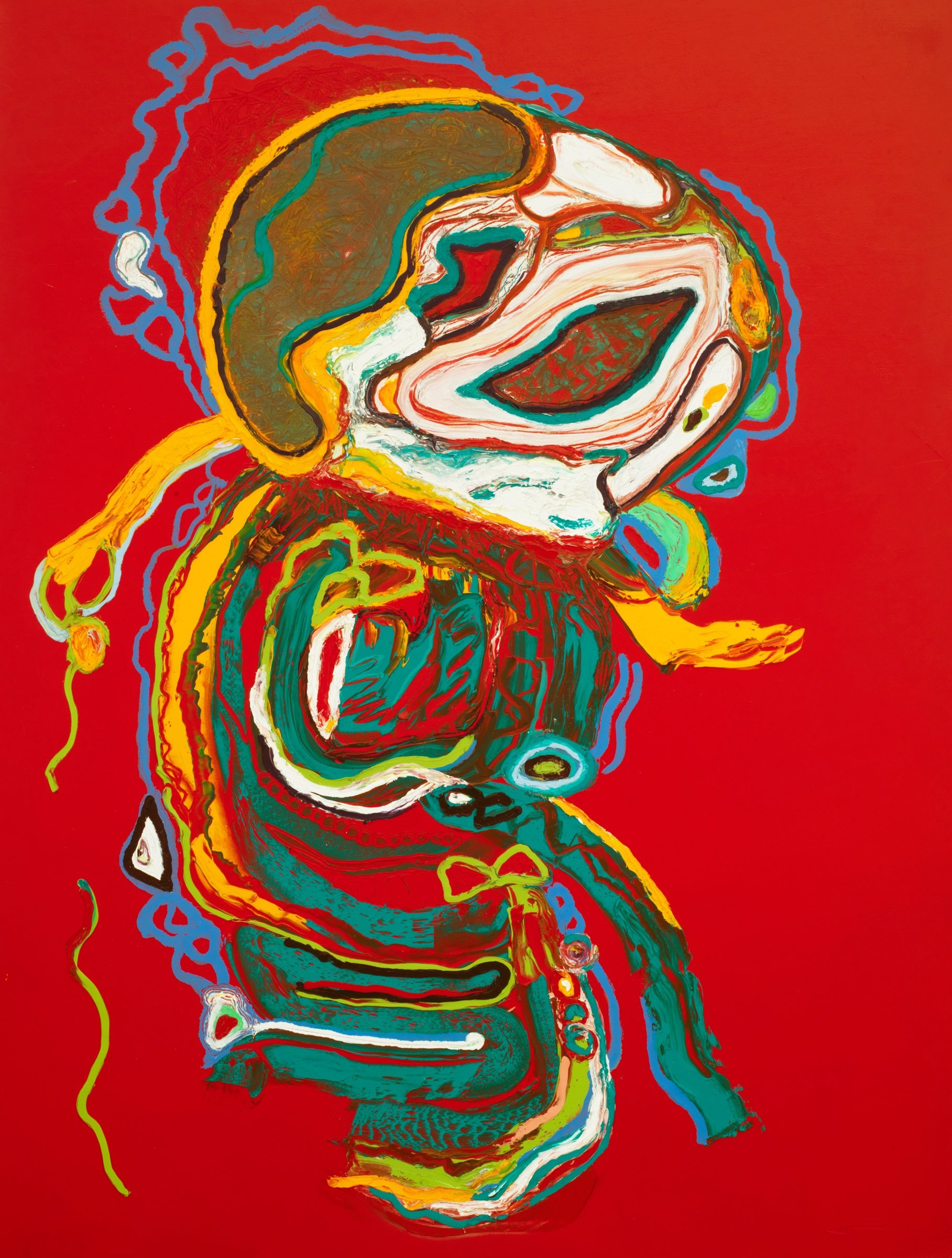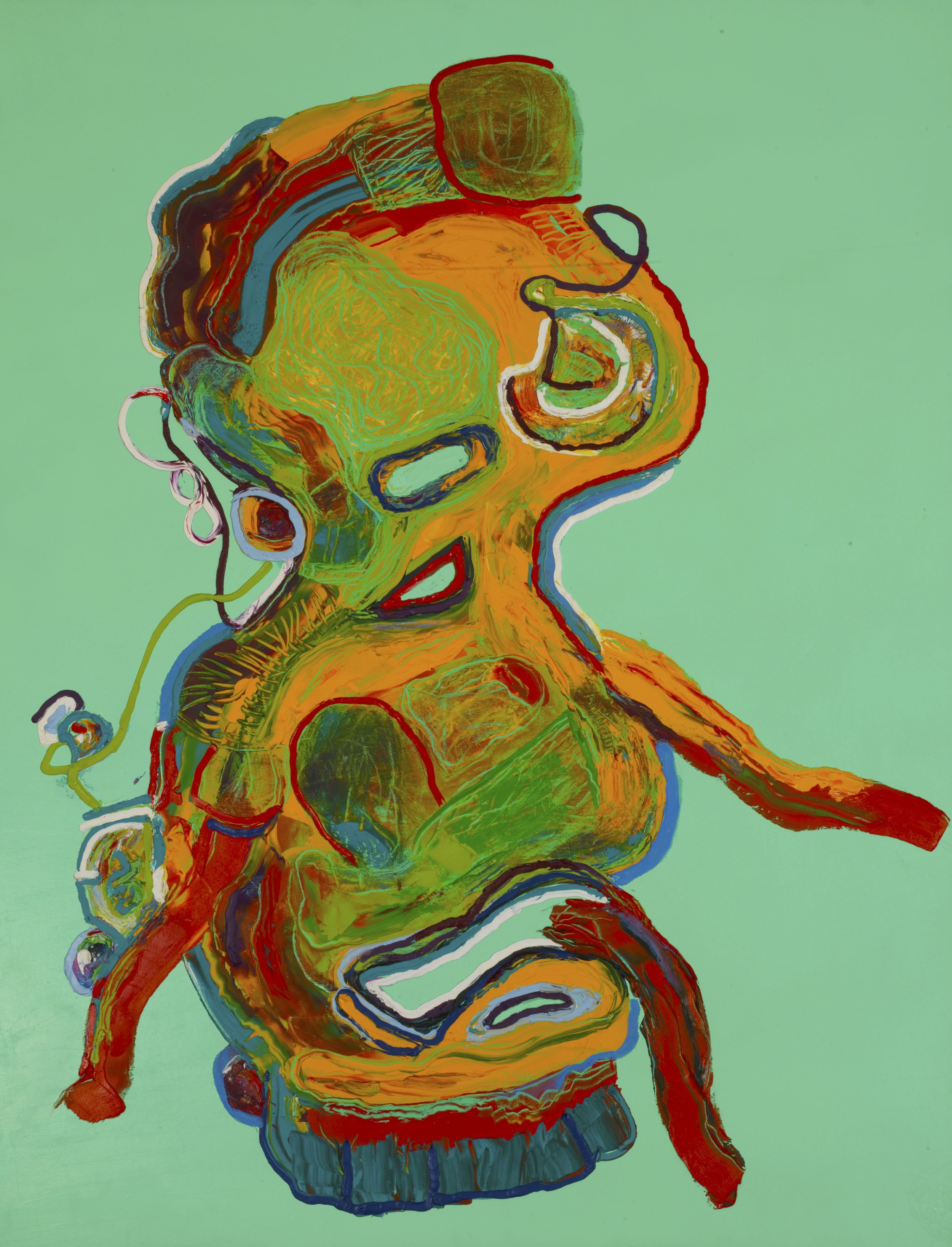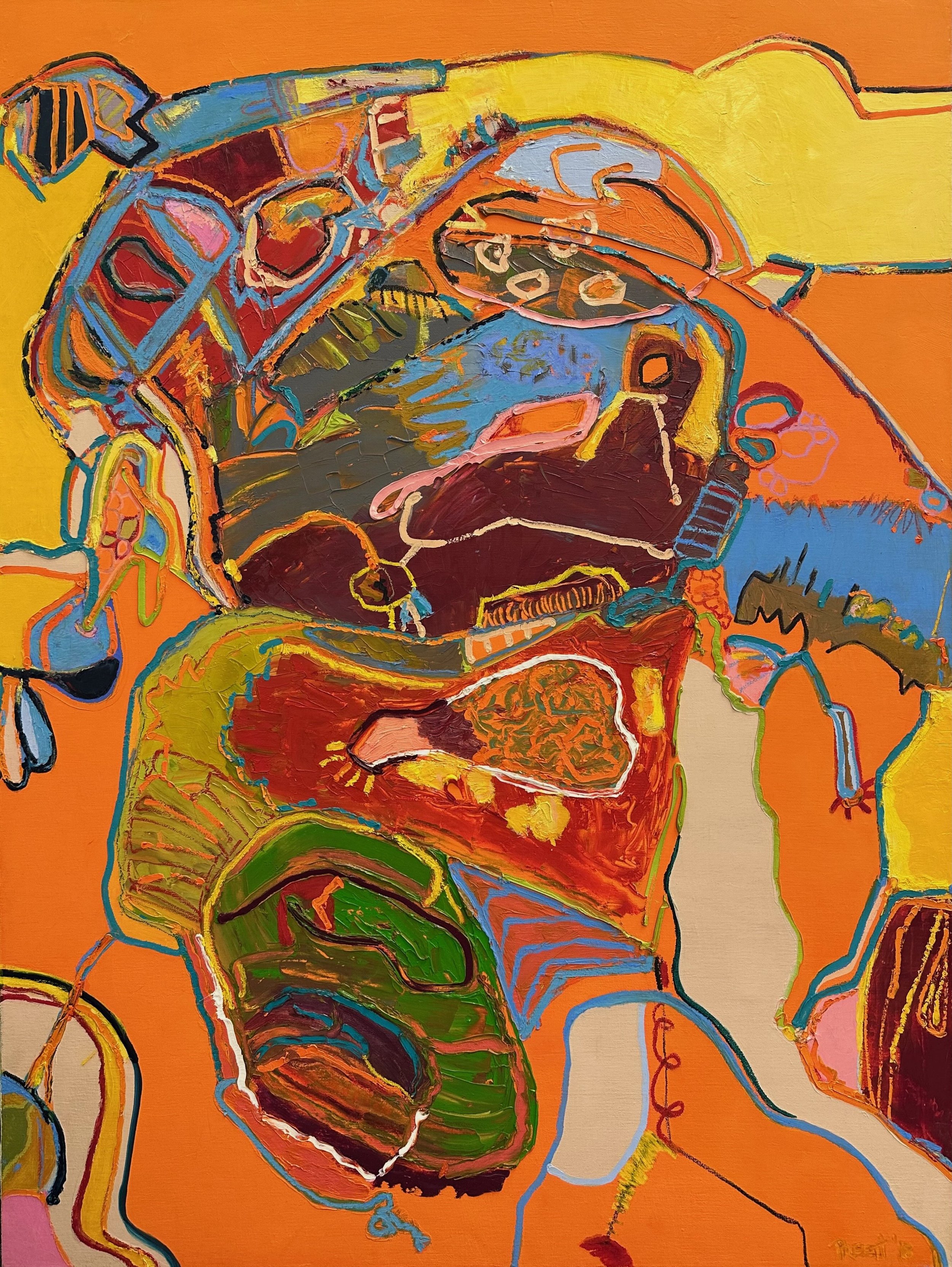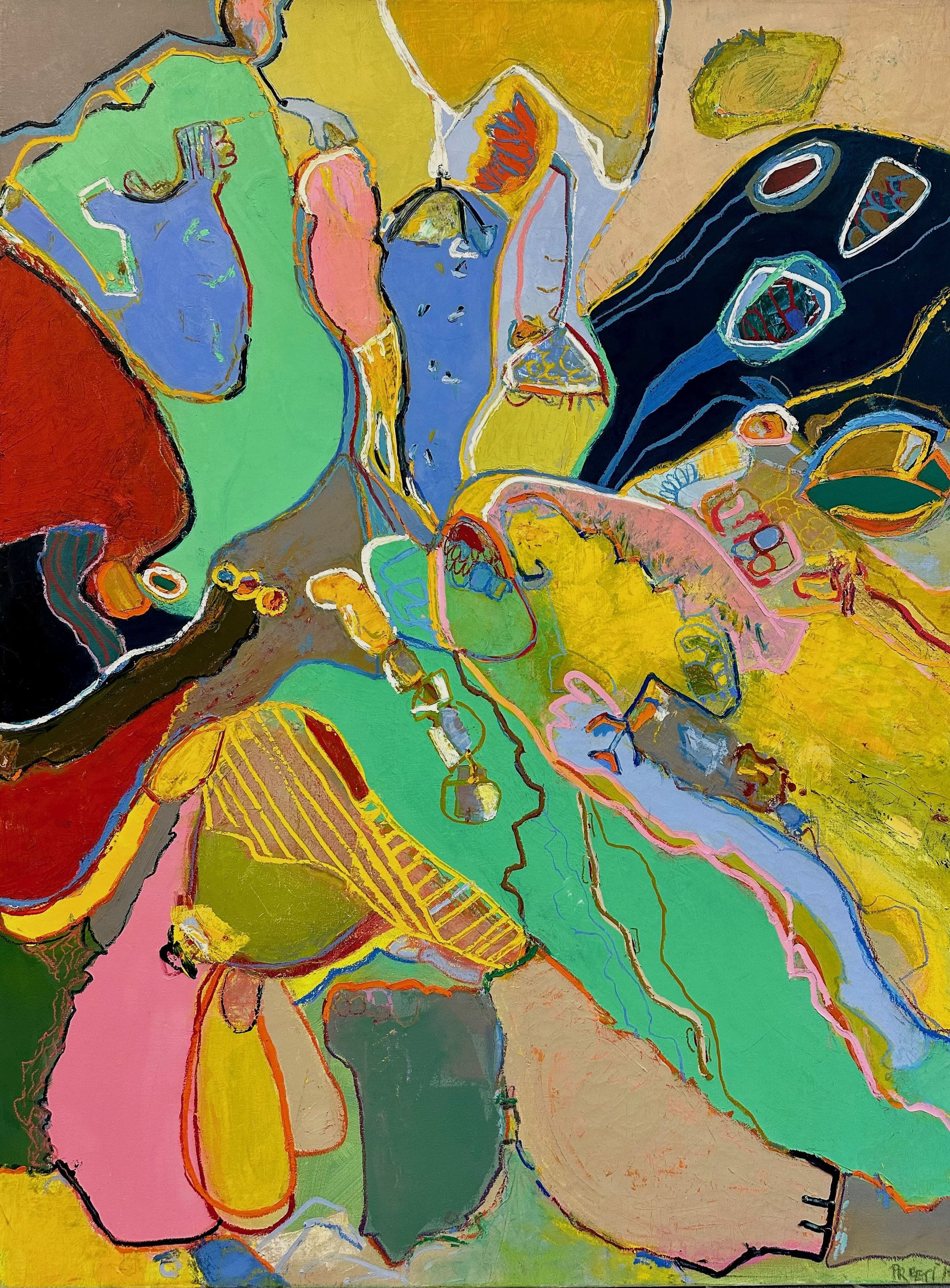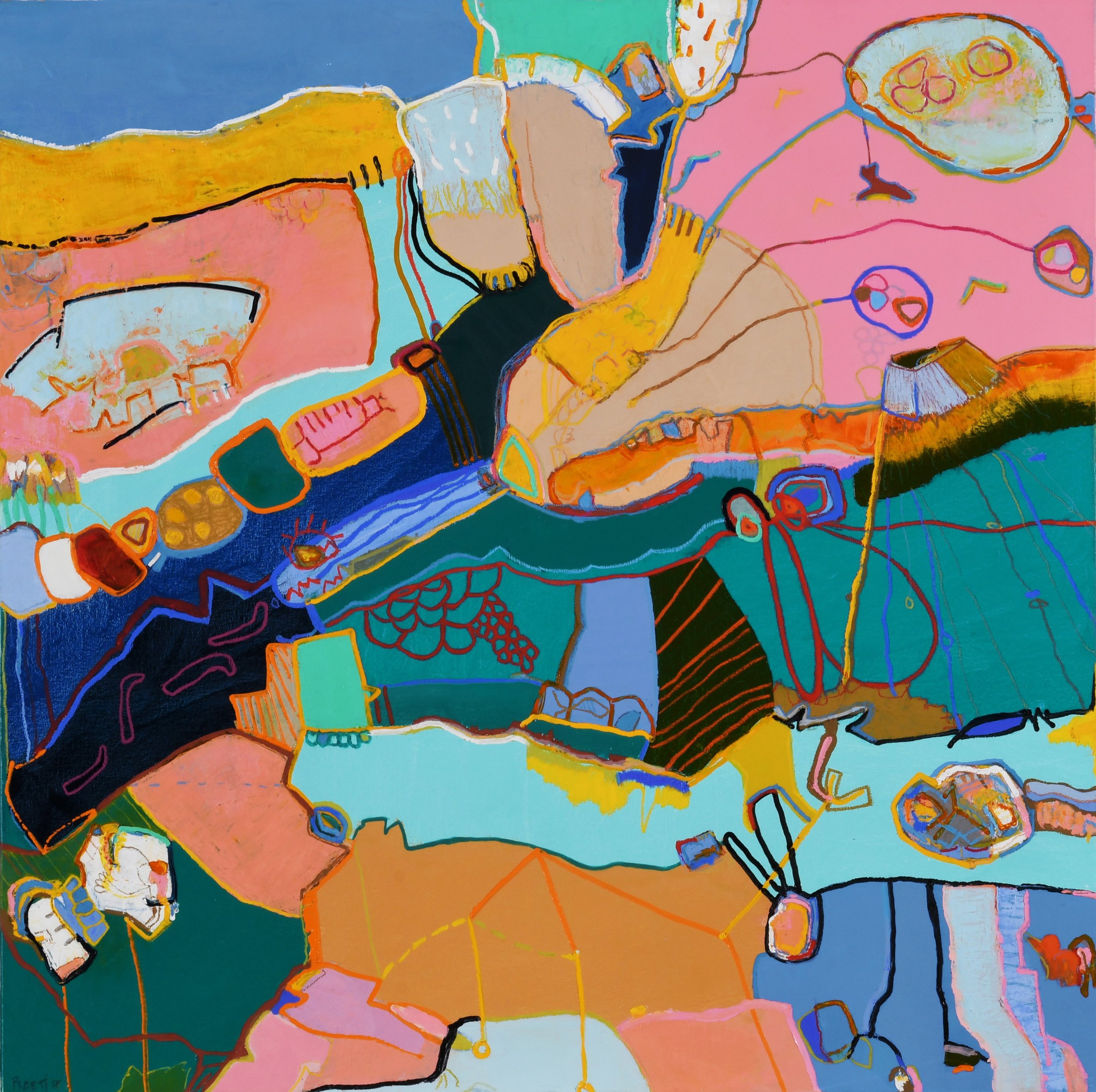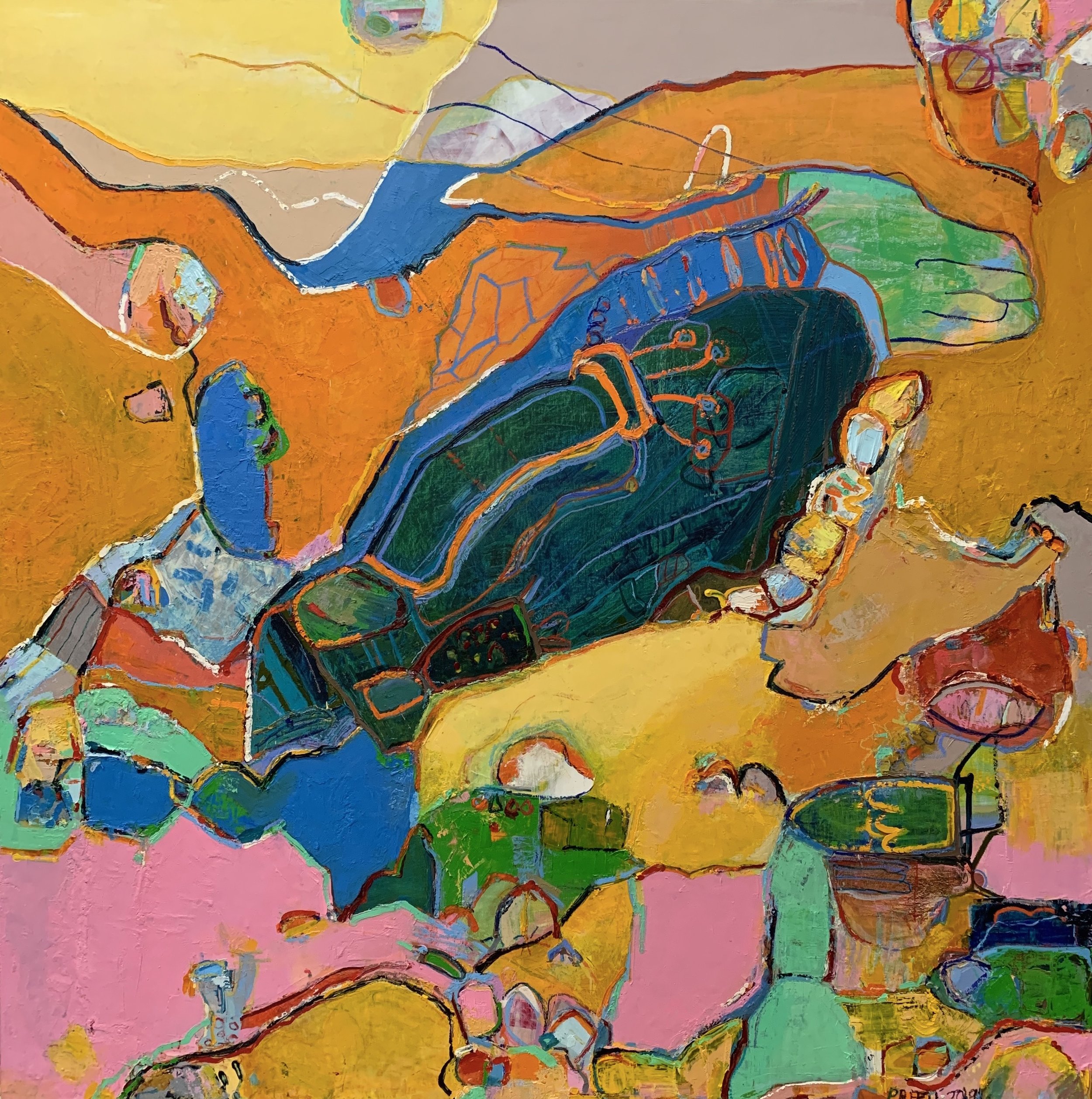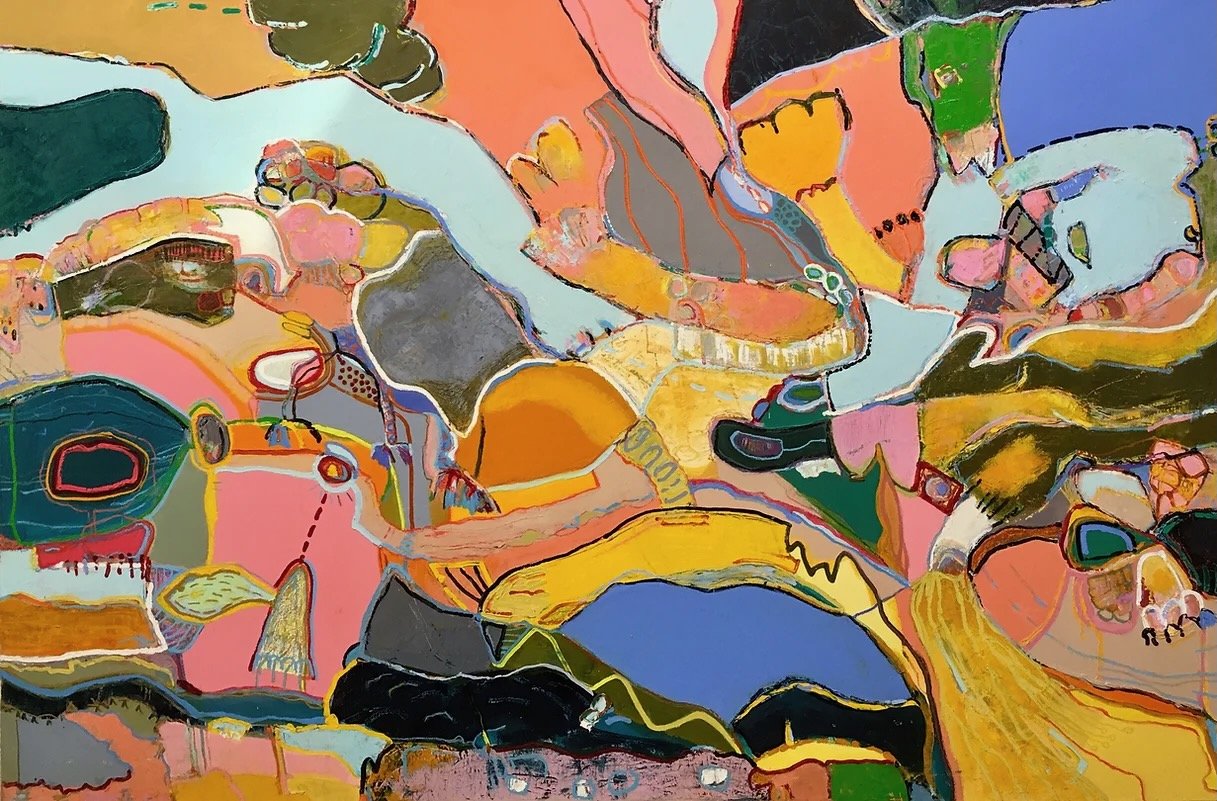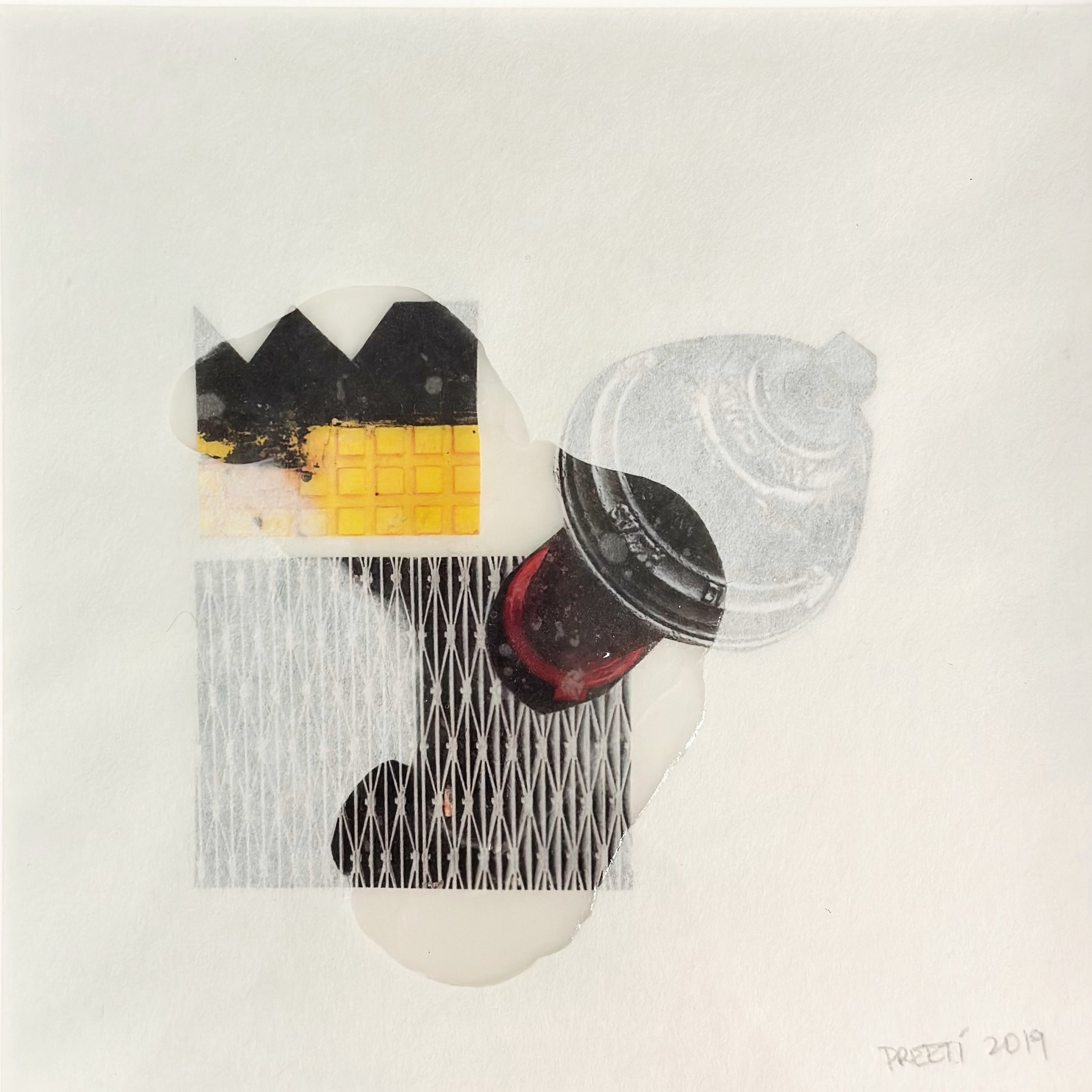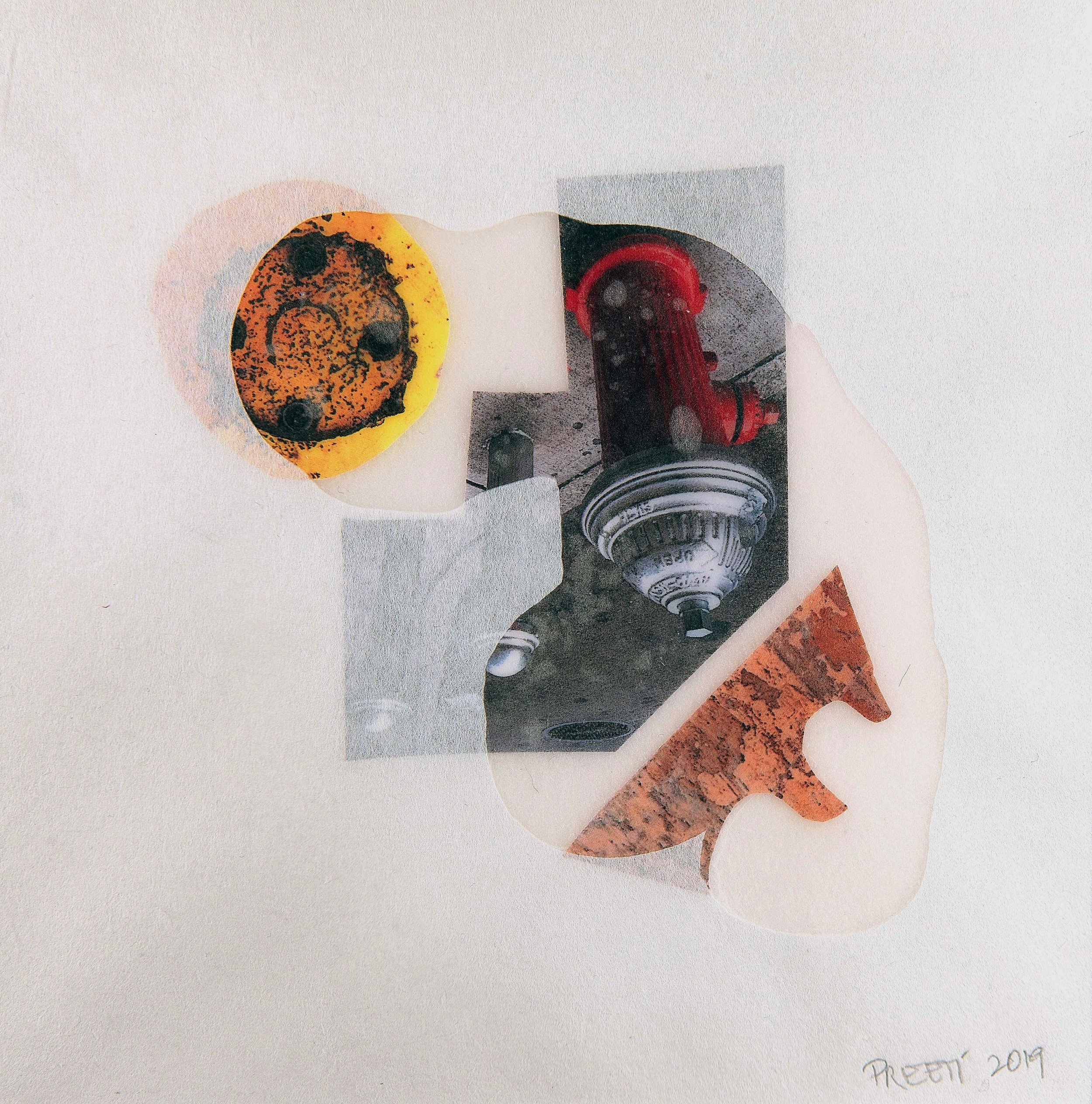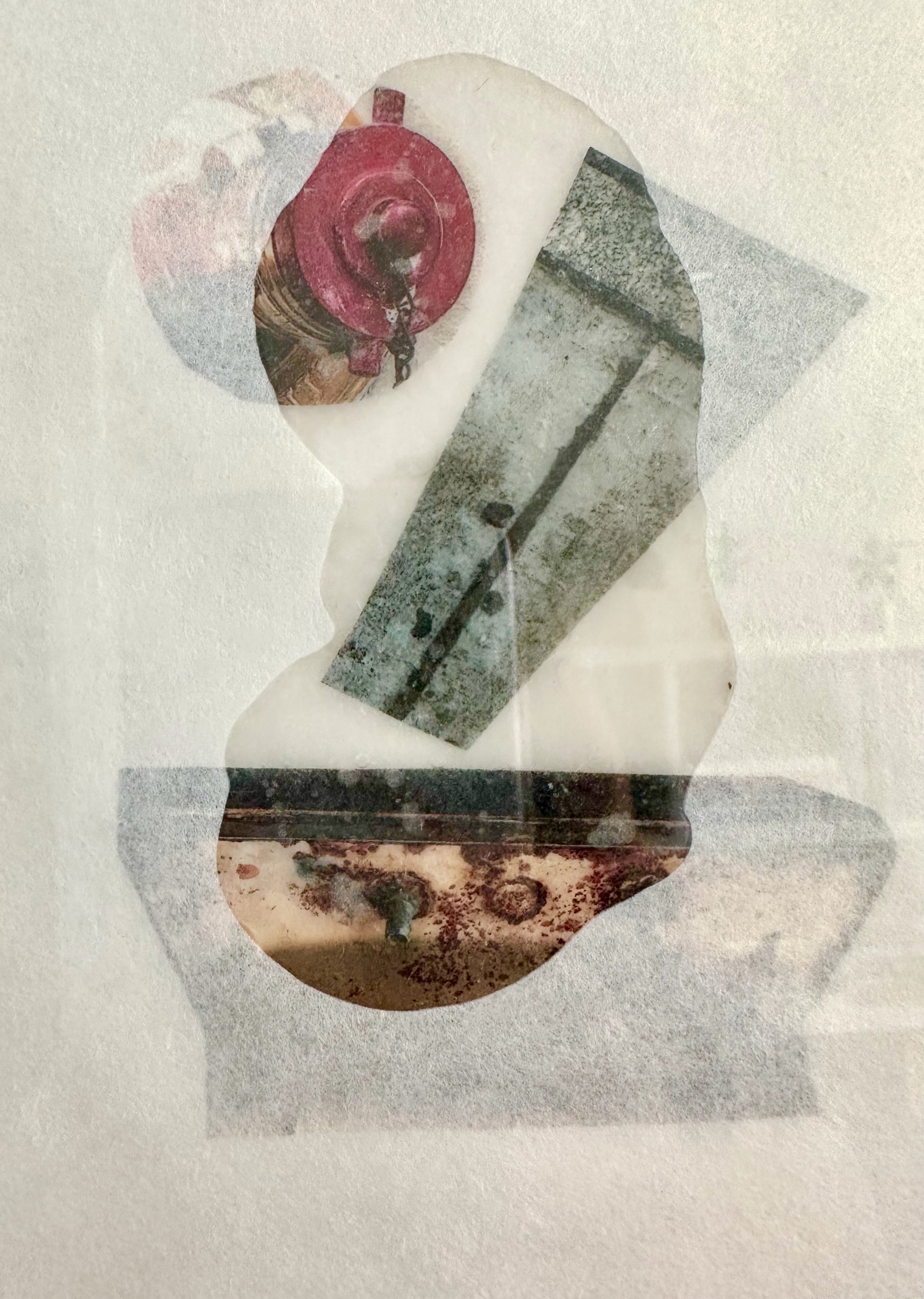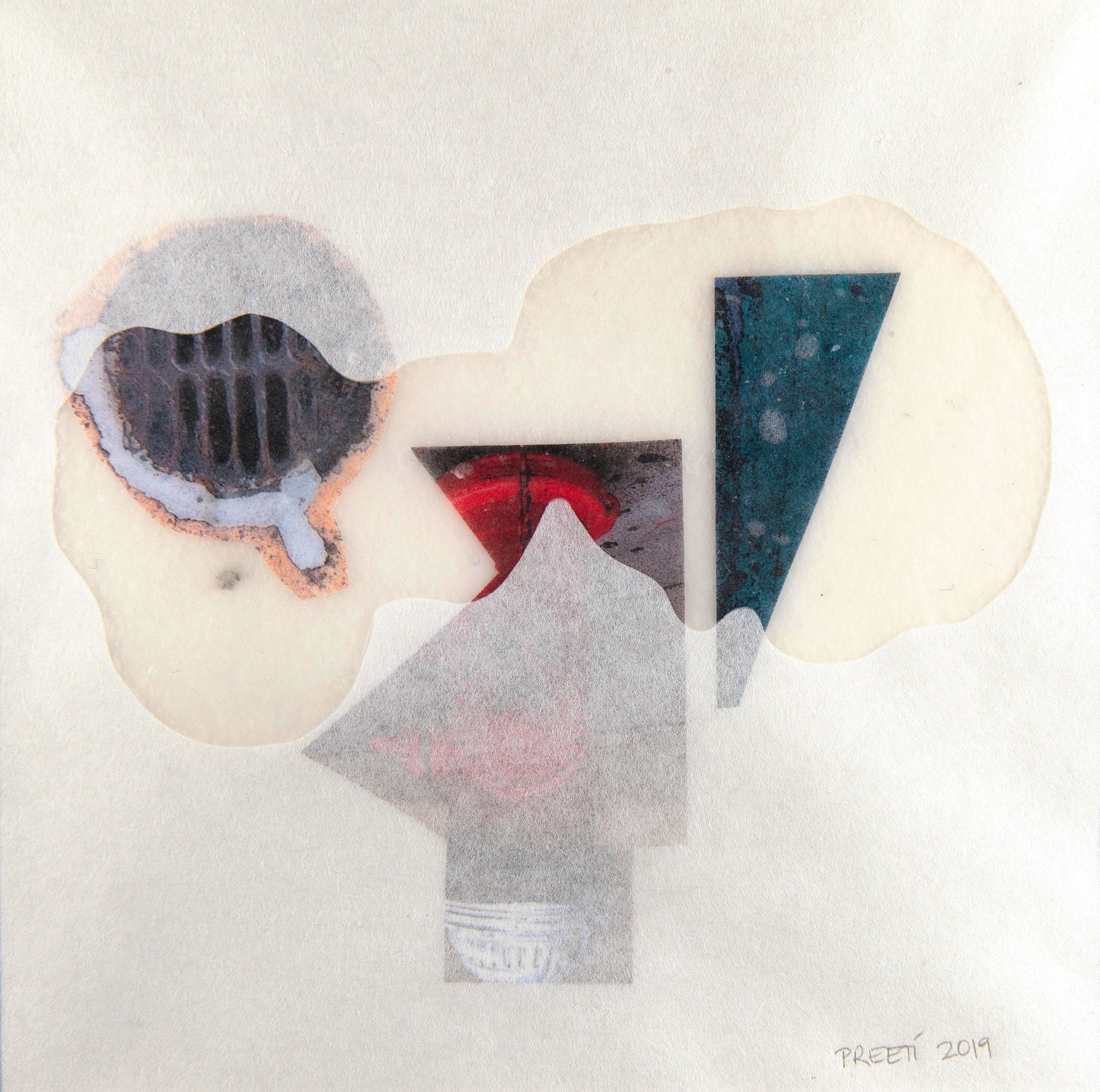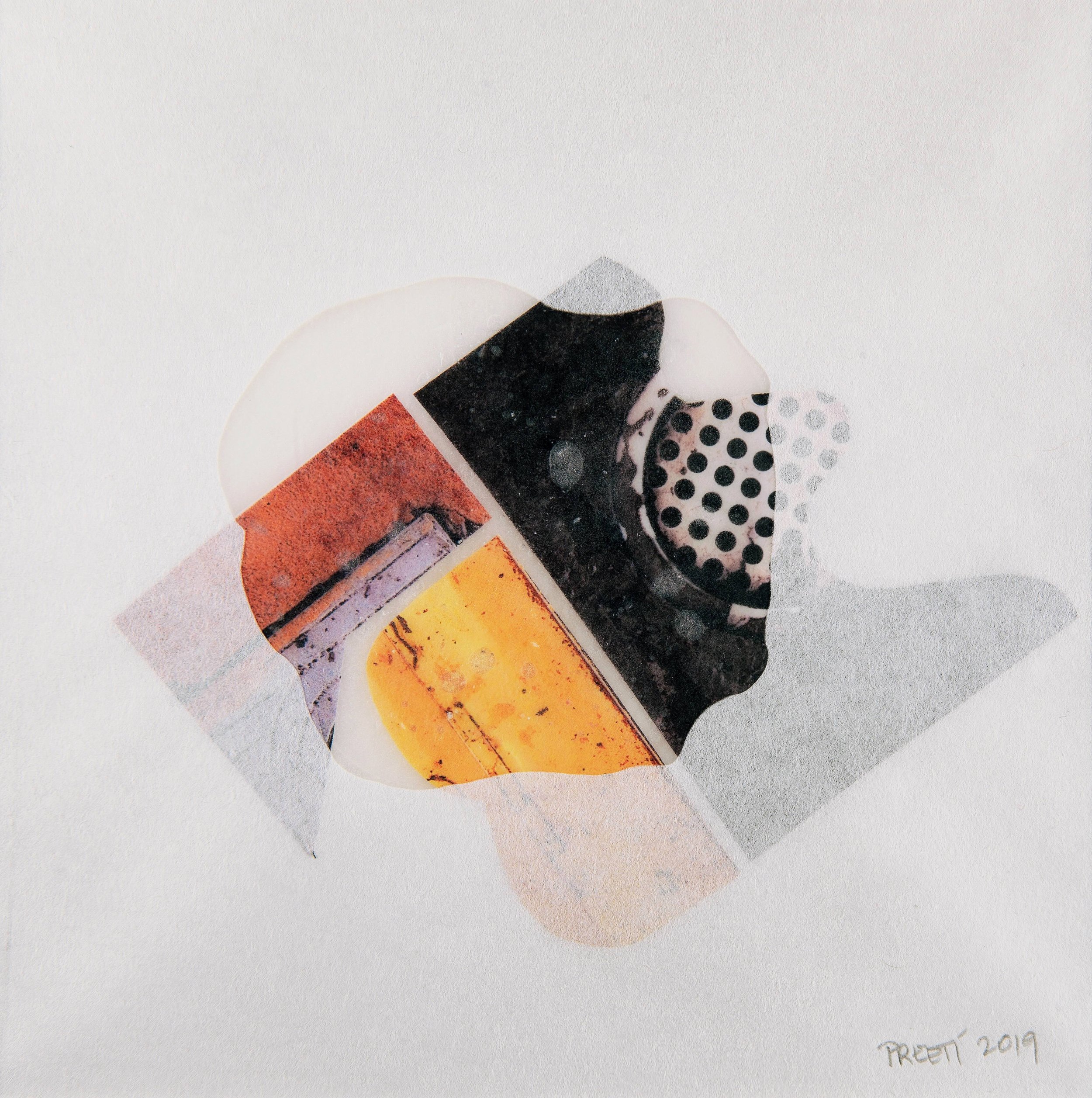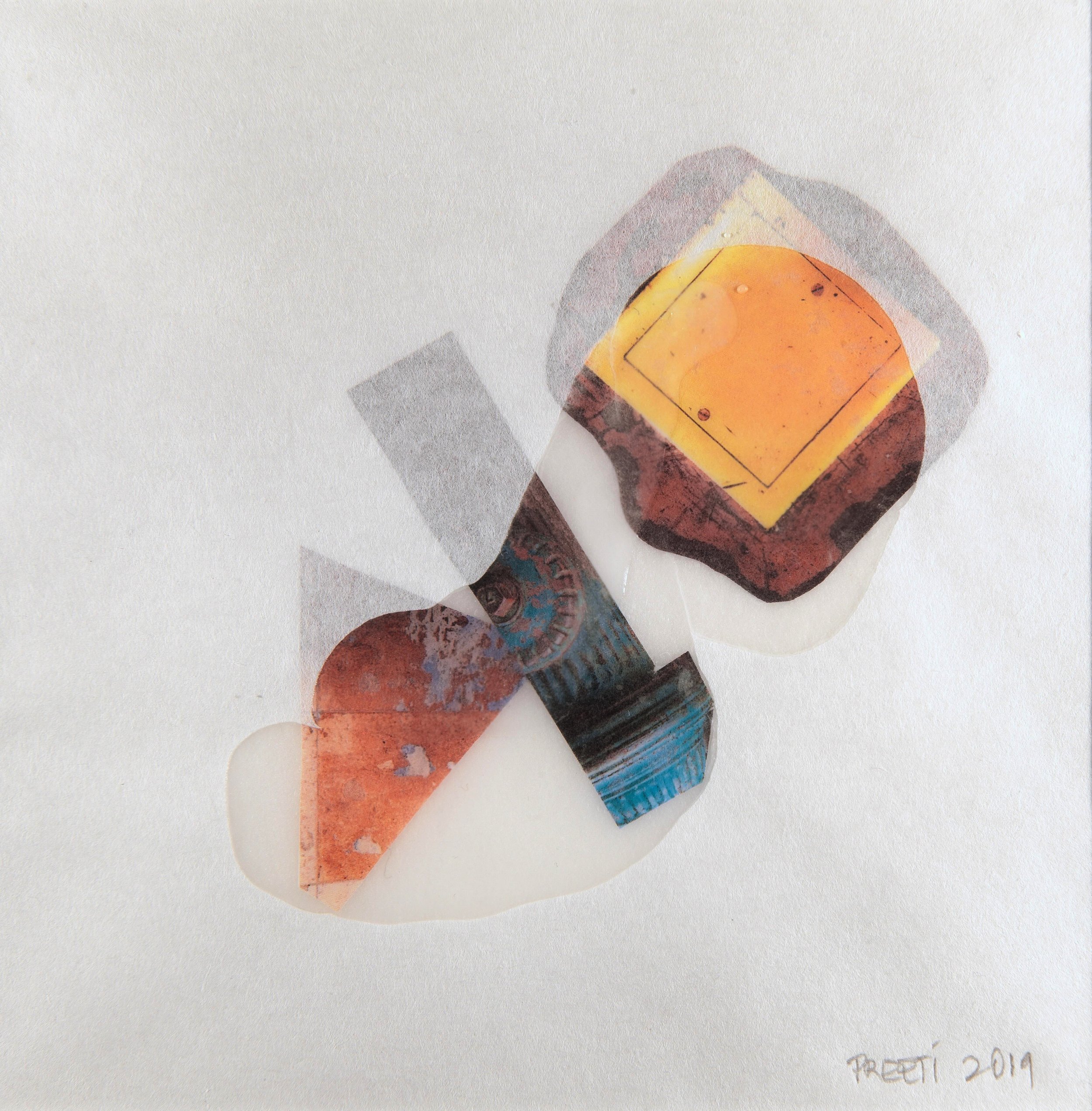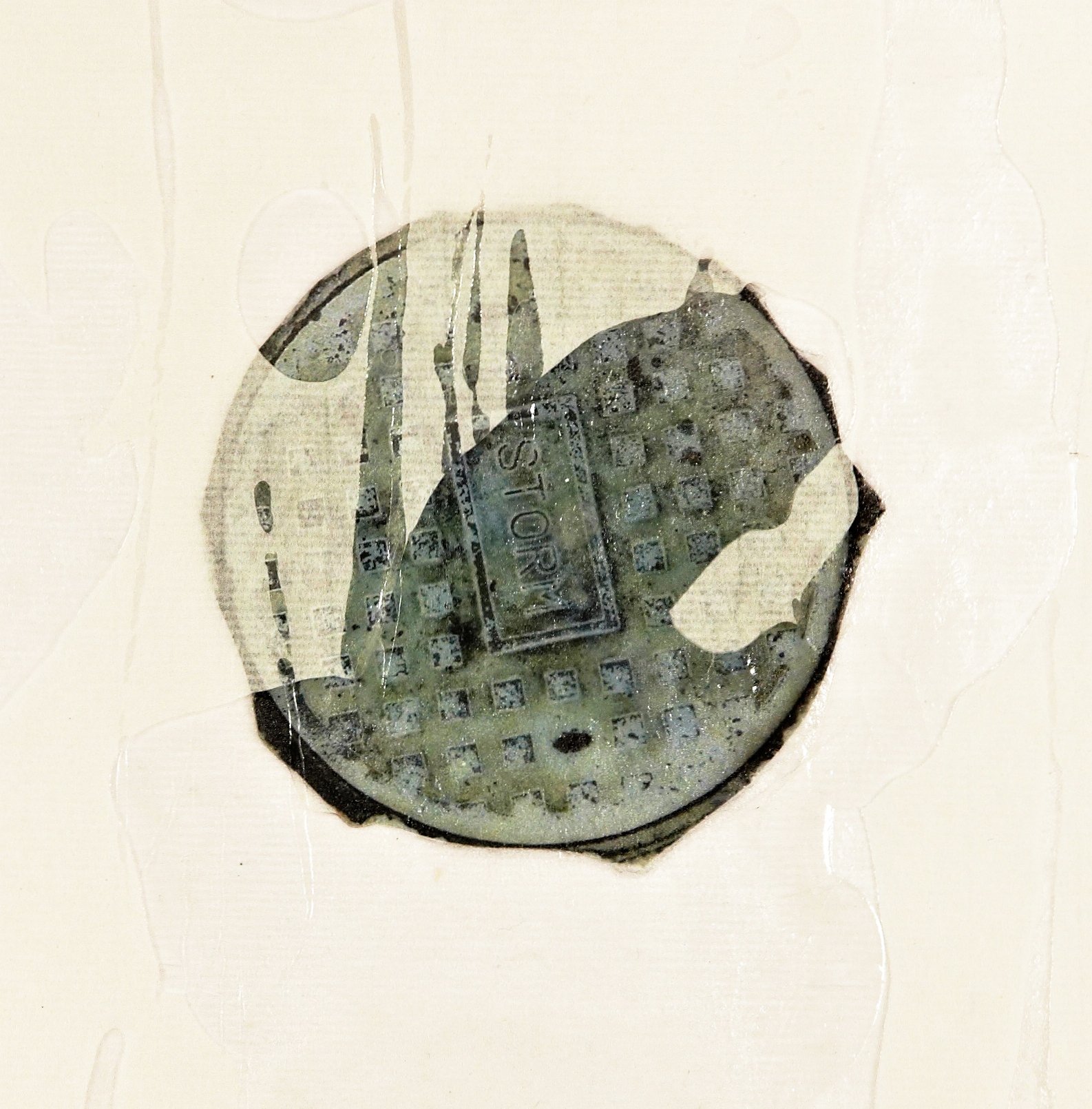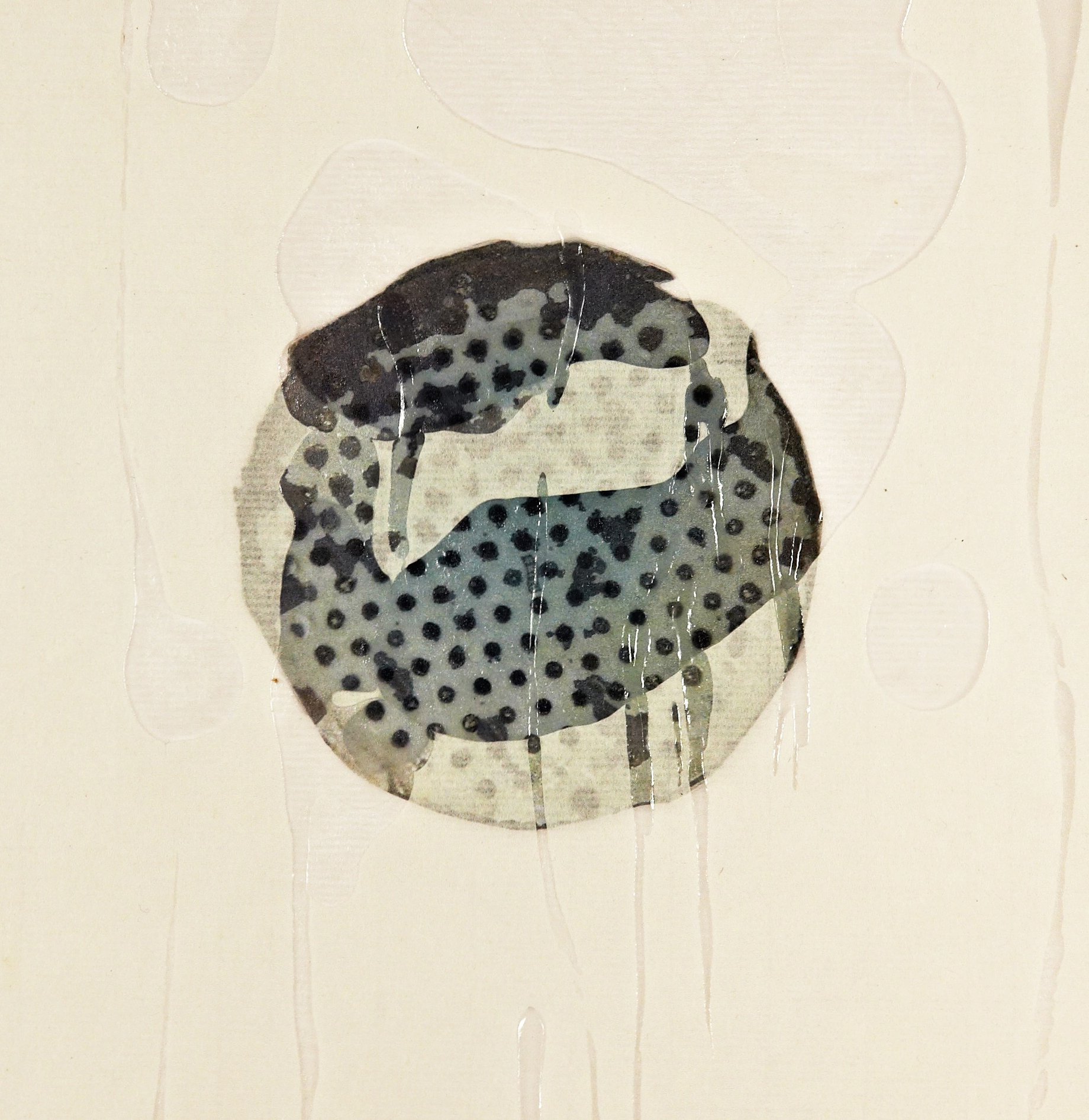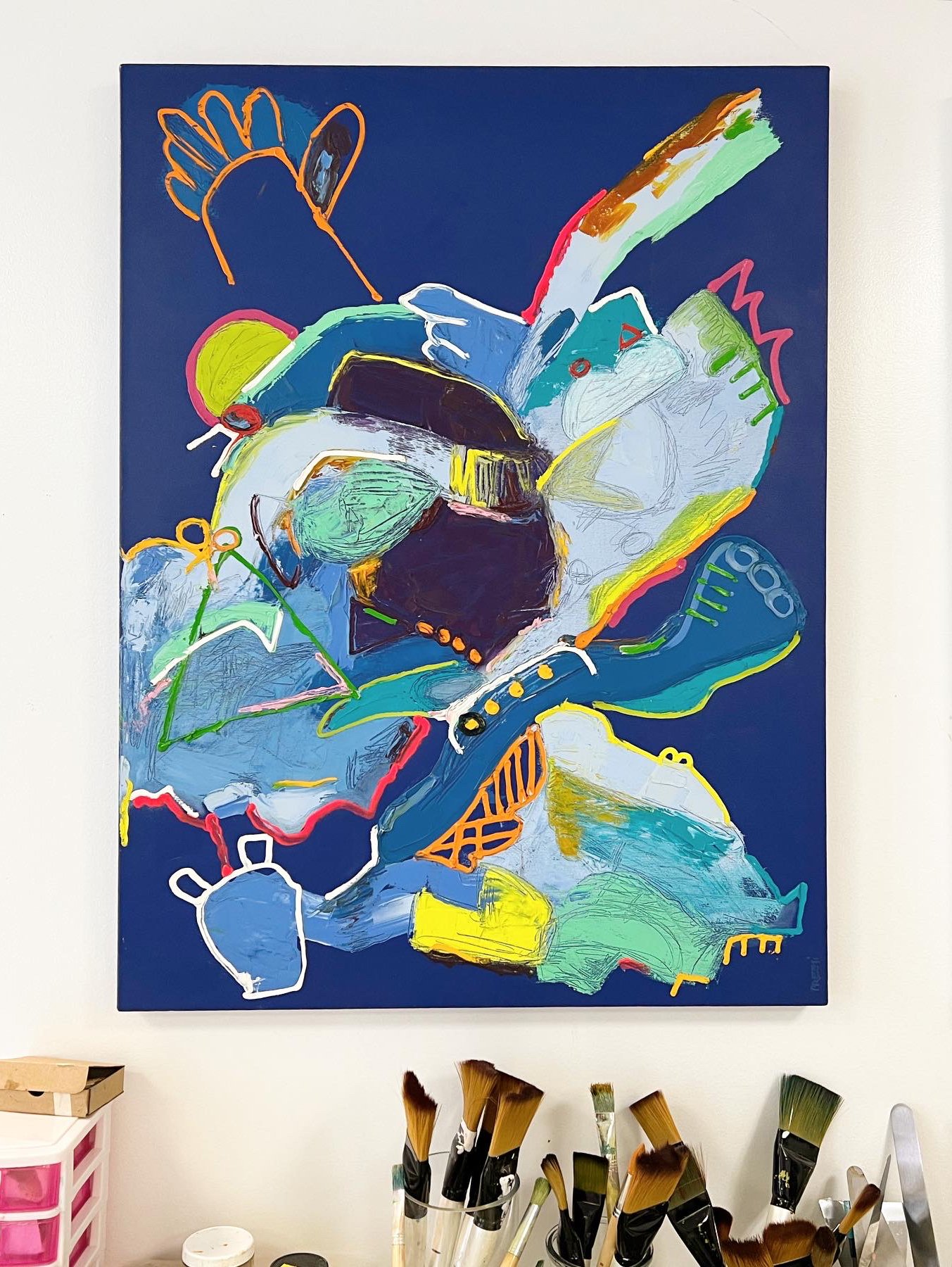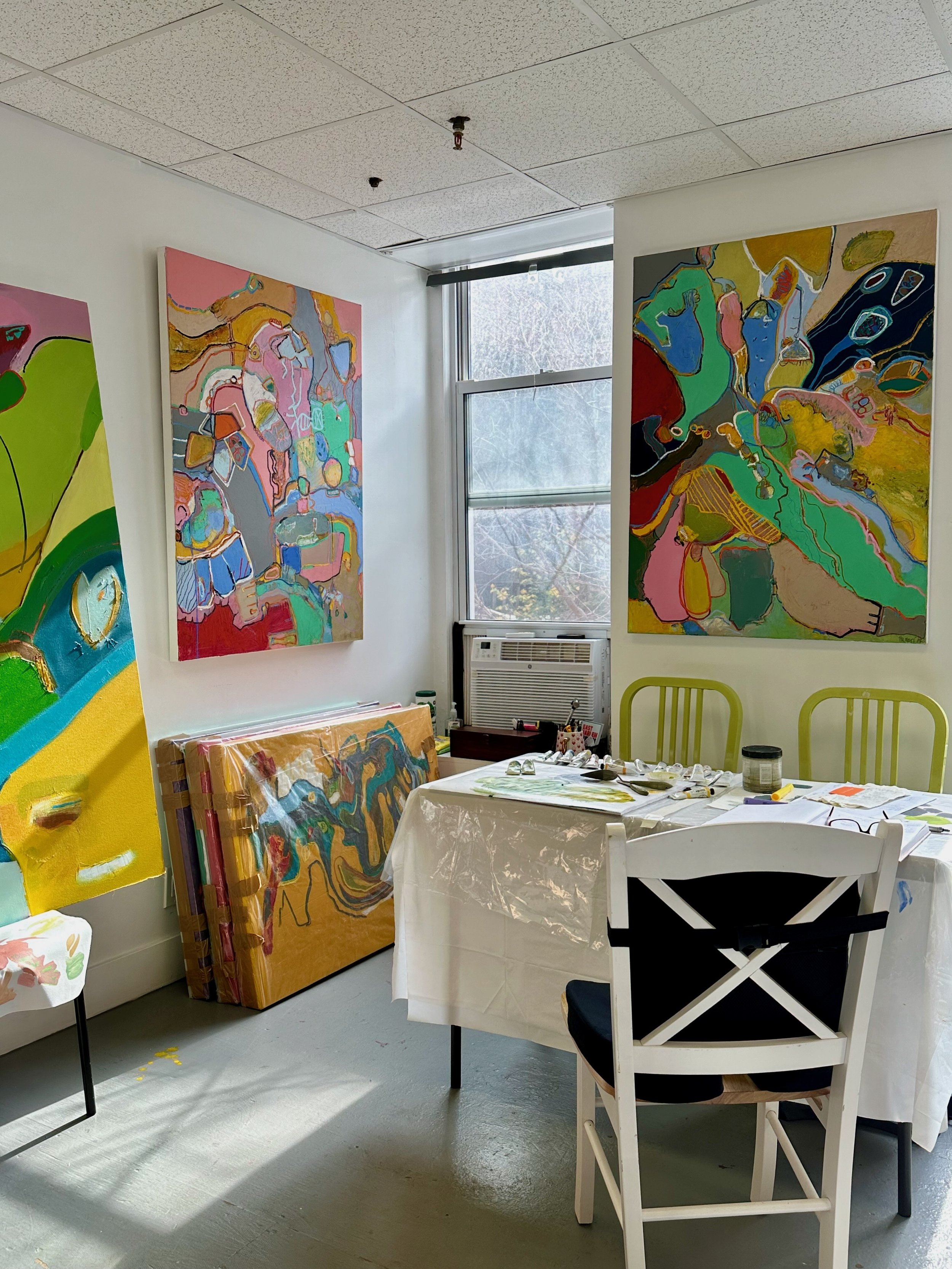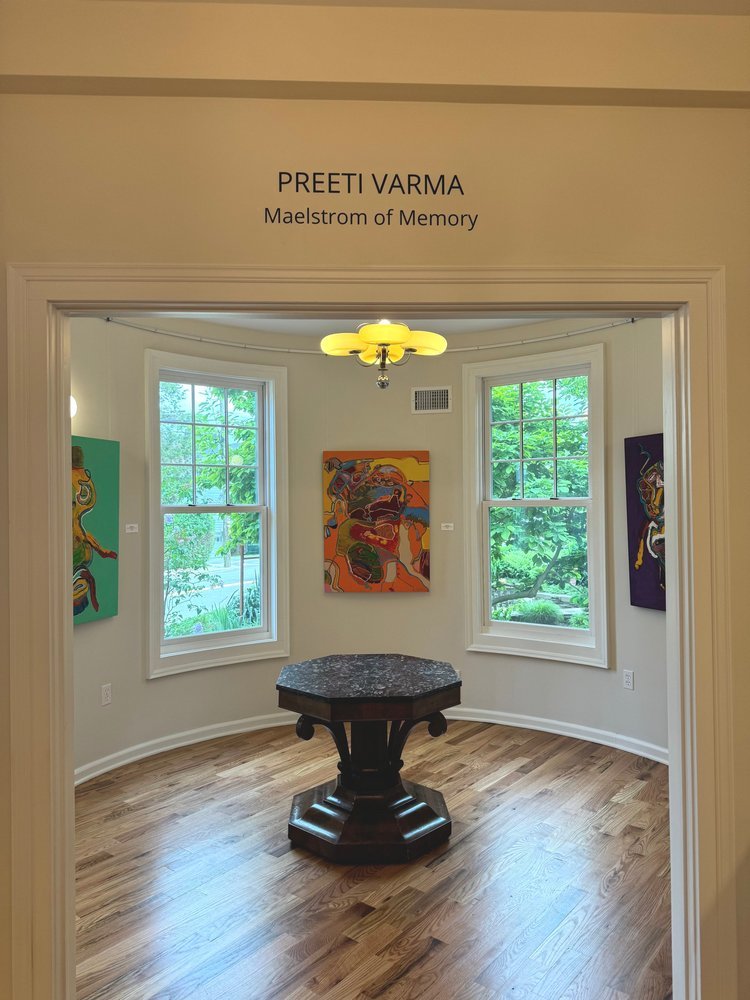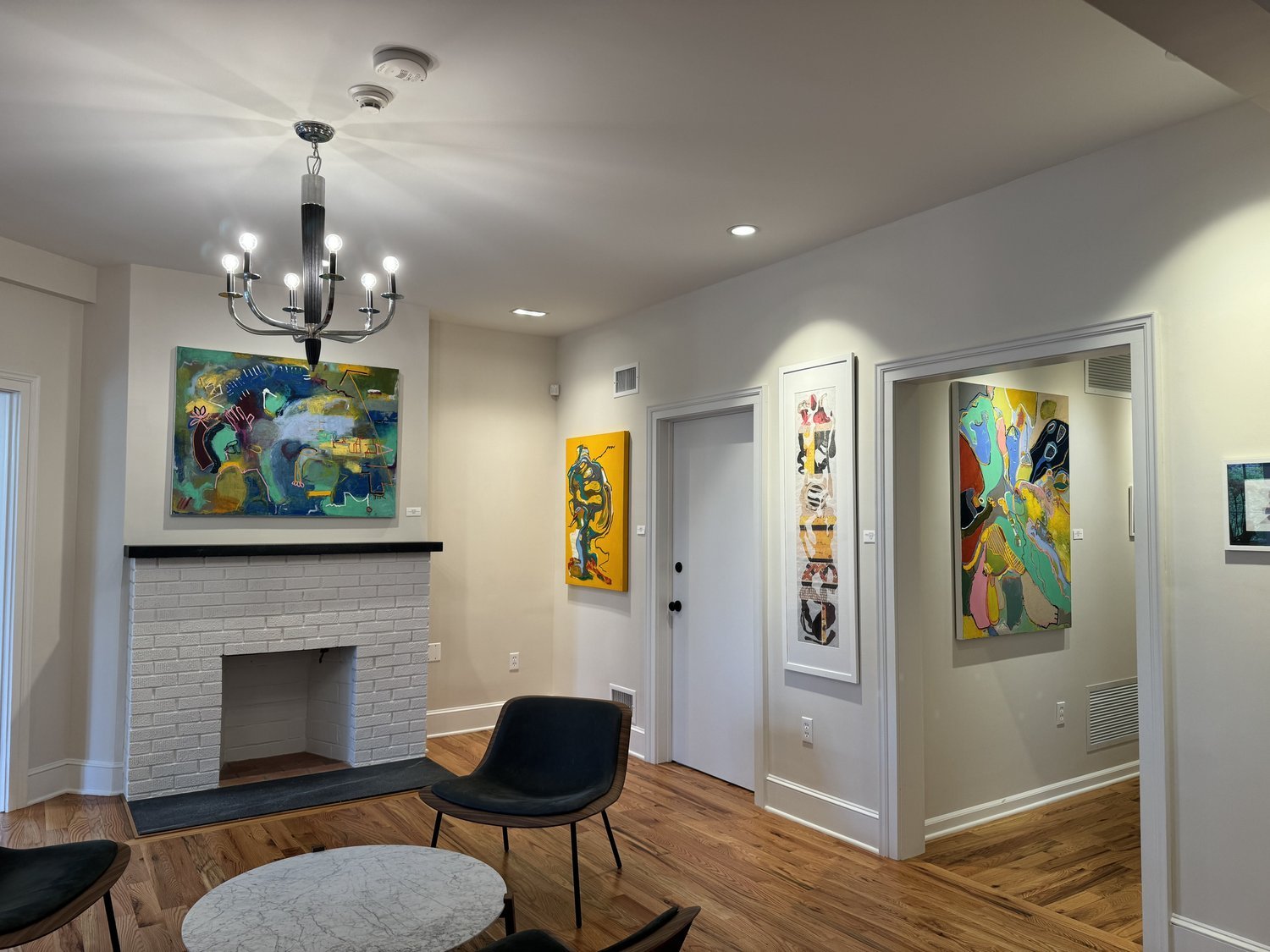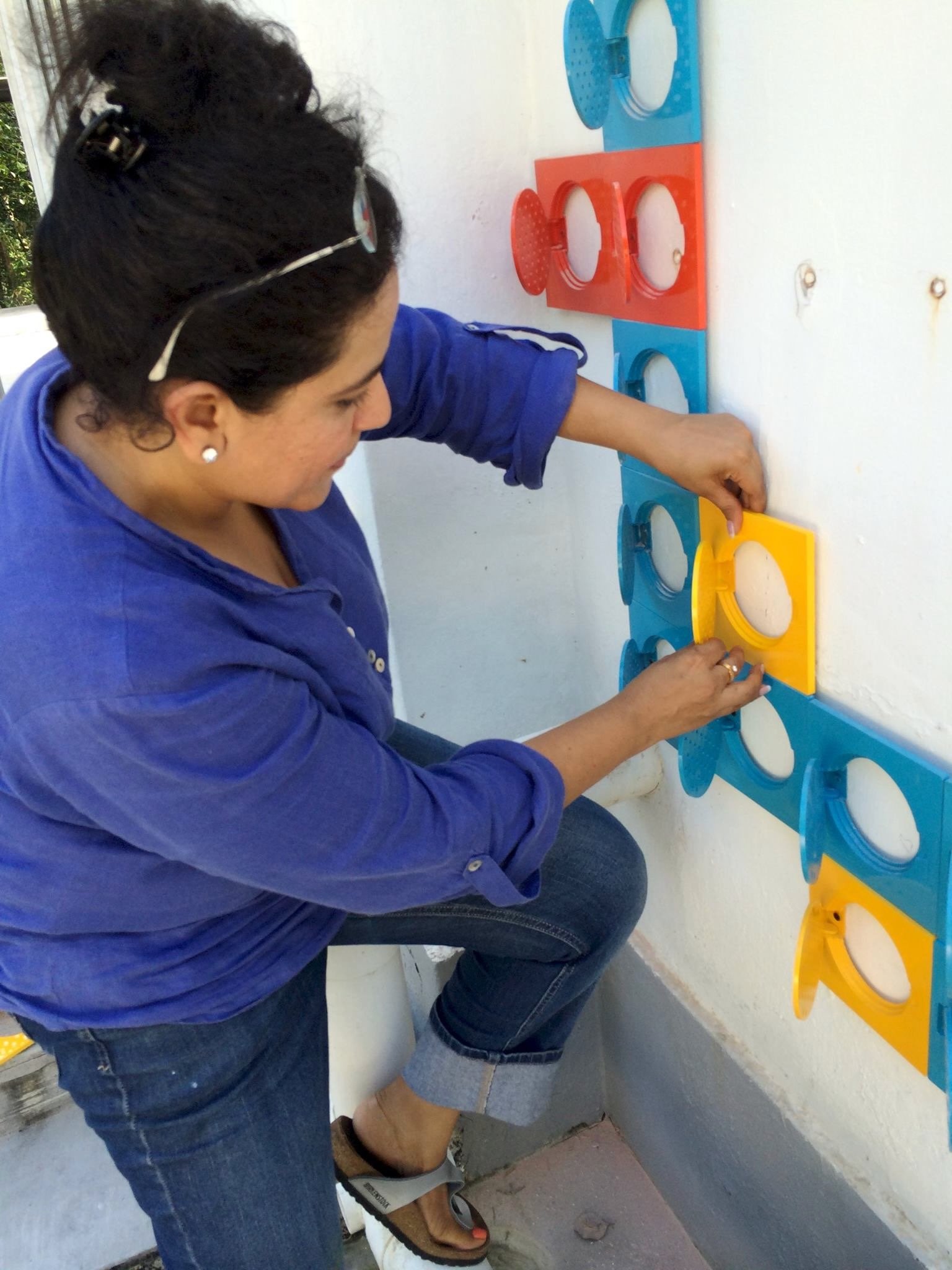In her new series of paintings, New York artist Preeti Varma distills her experiences of movement and migration to take us on a journey through unfamiliar territory. A native of India, Varma has traveled extensively in the East and West and knows what it is to be the other, accepted but not fully integrated into a new culture. Her paintings convey the multicultural experience with bold gestures, combining the subtle transitions of Eastern aesthetics with the formal structure of Western classicism. Varma depicts the psychological space of the migrant in constant motion, with flat areas of color that read as geographical expanses, offering respite for the eye as it traverses the canvas. Varma is attracted to ordinary objects that are all but invisible to the rest of us, depicting them with a life force so animated that we forget they are encrusted fire hydrants or rusty drains. The stark figure/ground relationship of these “portraits” suggests the immigrants’ social limitations, invoking compassion for their enduring sense of isolation. But these figures are not destitute; they are hopeful and courageous, reinventing themselves to reflect their changing environment. Varma paints with the joy and optimism that can only be known by one who is intimate with the outsider’s perspective; indeed, her work is a celebration of the itinerant nature of human existence. In her paintings and works on paper she creates a simulacrum of the outsider’s experience, a small taste of what it is to be in continuous transition. And as we’re drawn into her narrative, we come to understand that the hardships of the migrants’ circumstances compel the traveler to find beauty in the fleeting moment, that narrow slice of experience that, like Varma’s paintings, is in a state of perpetual flux.
MH: Your abstract paintings are vaguely representational. Sometimes they read as portraits, and more recently they appear to be still lifes or landscapes. How do you feel about content in your work? Do you want people to read into them and see subject matter? Or would you prefer that they view them as pure abstraction?
PV: I like people to see my paintings as pure abstraction at least to start with, but then at some point I like them to know what the subject matter is. I want my work to inspire the intrigue that everyday life possesses, the magic of the moment.But I’m happy for people to take away from them however it makes them feel.
MH: Is it easier for you to begin your paintings with a subject in mind, or do you work better without any preconceived content?
PV: My creative process is a journey of absorbing the world around me, which is part of my subject matter. I don't start with anything set but begin by taking in my environment through my experience of walking around the city. I encounter seemingly ordinary things that exist without anything remarkable happening to them, and then something sparks my imagination. I photograph it, and then stories start to build up in my head, and it all comes together in the work.
MH: You expressed that you find inspiration in everyday objects. How do these ordinary objects inspire you?
PV: I’ve always felt for the underdog, and I sometimes wonder if I’m looking at these things because no one else looks at them. So that’s one school of thought, but then I started looking more deeply into it, and I saw the contrast of the many places where I’ve lived. When I moved to Singapore, for example, everything seemed so clean and perfect compared to India, but then the imperfections started jumping out at me and I found them intriguing. And that made me think about how in India those imperfections were always there, but I never noticed them. It’s the context that makes us see what we see and how we see it.
MH: You’ve moved many times in the last decade, leaving your home in North India and eventually ending up in New York City. This must have had a profound impact on your studio work.
PV: Yes, the changing environment has completely informed my work and has given me an outsider’s view. I have that ability to look at something with fresh eyes, from a certain angle, with a kind of novel experience that natives don’t have. Like a fire hydrant. It may not be special to anyone who sees them all the time and who grew up with them, but I see a fire hydrant and I see a unique identity. They stand on each street, separated by their own experiences, exposed to the ravages of time – to me it’s fascinating. I feel like everything is living and has life.
MH: It’s funny how of all things, fire hydrants stood out to you.
PV: Isn’t it? (haha) I started painting them as portraits, taking my inspiration from traditional portraiture, which were painted for people of status. So I elevated fire hydrants to similar levels of importance by painting their portraits, and I made the ground behind them very flat.
MH: Are there other ways that your work been affected by living in so many places?
PV: I was painting when I lived in India, then when I moved to Singapore, I started working with rice paper. I was inspired by the Asian art of storytelling and calligraphy on paper, so I was using my photographs and responding to contemporary issues through that tradition. I did that for 4 years, but when I came to New York the energy of the city was so vibrant and noisy that I couldn’t express myself in the same way. I would sit down with the paper and images, but I couldn’t express how I was relating to my new environment using the same materials, and that was when I felt that I had to paint. The work that I was doing in Singapore was much quieter, but in New York my paintings became more vibrant.
MH: In moving around for so many years, you undoubtedly had moments of feeling like the other, the outsider. Do you feel a connection to the migrants who share that profound feeling of loss?
PV: Yes, I do, and it stood out to me a lot more after moving to New York with its rich migrant history. As artists, we experience life deeply, and our compassion helps us express our artistic intent to reflect our collective humanity and resilience.
MH: When I spend time with your paintings, I feel like they take me on a journey. It moves from left to right, but it also seems to move away from me, migrating into the two-dimensional space. Is this sensation intentional, and if so, where do you want to take your viewer?
PV: It’s a lovely question. Movement has always been important to me because even when I lived in India, I was constantly moving within the country. I try to express this movement in my paintings, and I’d be so happy if someone felt like they were going on a journey with me. I always start with strokes from left to right, and then everything starts slowly, magically building around it. I want the viewer to keep travelling with me, to keep moving in and out of the painting. I don’t want them to stay in one place, so there is no static point in my work, even with the works on paper.
MH: That’s interesting. The viewer becomes an essential part of the painting, holding it together, as it were.
PV: Yes. I sometimes refer to my work as experiential, because it comes from these experiences that I’m constantly documenting. It’s a distillation of many experiences, which means that each work is unique; there is no template. I’d die if I had to work with a template! Formulas feel like death to me.
MH: Haha! Death by template. But is the artist the best judge of her work? Sometimes what we see as formulaic failures turn out to be what others like best.
PV: I don’t’ know about that. My work needs to be authentic to myself first before it’s true to anyone else. I need to be able to own it.
MH: Your work is so much about movement and rhythm. If you were a writer, your language might be based in verbs rather than nouns. How do you feel about your work being described as a verb?
PV: Interesting. I can totally relate to that because it’s in constant movement, and the moment you rest your eyes somewhere, you feel the need to move to another place. But there’s also an interconnectedness of the elements, of one thing leading to another. It’s a formal element that I want my paintings to have, like building a visual story, and all the elements are characters in the story.
MH: It makes sense to think of your paintings in terms of writing, because they often read as narrative. It appears that the color and calligraphic marks are telling a story in broad strokes, and I’m curious if this narrative is your life story? In other words, are your paintings autobiographical?
PV: Maybe they are. It would be hard for me to separate the movement of my painting from my unique way of looking, which comes from my shifting perspectives. So in that respect I’d call them autobiographic. I can be a private person, so being an artist gives me the ability to share my life.
MH: On a similar note, you mentioned that your paintings express the subject matter from the inside out, which makes me think that they’re self-portraits. Is this how you view them?
PV: I’ve asked myself this question for the last several years and I struggle with it. It may have more to do with my search for identity as an outsider. Maybe immigrants share this experience, a sense of an environment reflecting who you are at this time, in this moment, in relation to the space you currently inhabit. In my paintings there are passages that I think of as geographic because I have a relationship with spaces and how I relate to them. It’s reflective of how I’ve felt over the years of moving from one environment to another. When you go to a new land the first thing you notice is how different it looks. The second thing you notice is how different the people are and their language is. So I think my work has always been steeped in those contrasts, going from the outside in, and does the outsider ever become an insider? That’s difficult. It takes a while.
MH: You seem to embrace the imperfections in your immediate surroundings and find most of your inspiration in the urban landscape. You said that you’re “…elevating the ordinary to a level of significance and reconsidering what beauty might be.” Would you elaborate on that?
PV: The eye is trained to think of beauty as having a completeness to it. It wants to rest on things that appear to be whole, where nothing is missing, and we elevate symmetry. But we can see beauty in anything, and find meaning where we are, because it’s all around us. There can be moments of contemplation and beauty in very banal things.
MH: Have you always seen the beauty in everyday objects? Because when you’re constantly moving you have no home base, so you might be more inclined to find the beauty in fleeting moments and everyday objects.
PV: Yes, 100%. I’ve always gravitated towards beauty, and living in so many places has made me a keen observer of my immediate surroundings. I’m a very curious person, so I’d be intrigued and appreciative anywhere you put me.
MH: It’s an interesting inversion that the migrant’s experience becomes so focused on the present, the immediate, the now. You’d think that someone who’s traveled the world like you have would find beauty in the big, wide space of existence, but instead your focus is on the narrow slice of experience that comprises the present moment.
PV: It’s due to the realization that these ordinary things exist everywhere, and they have a similar ordinariness to them. Looking at these elements brings a sense of familiarity, even though they look slightly different from place to place. But they have the same feeling about them, and the way they’re neglected and overlooked is the same everywhere. So my concentration on this makes me feel that there is a universality of experience for those of us who move around. An outsider is an outsider is an outsider. It doesn’t make any difference if you’re an outsider in your own country or in another country. And if I focus a little inward as I move around, it’s because that’s where the truth lies, in the end.
MH: As someone who’s lived in Delhi, Bangalore, Bombay, Singapore, and New York, you’re uniquely positioned to draw upon both Eastern and Western aesthetics in your studio work. How do you approach this? Is it something that you premeditate, or do you let it find its own expression?
PV: The latter. But I’m aware of it, and I do not suppress it because I want the work to have the best of all worlds. I hope it adds rich layers to my work. India is a land of color, which comes through in my palette, and I always want my work to be contemporary. The color is not static, it’s part of the present, and it’s a language that I use so people can take the journey with me.
MH: A lot of artists still think that art is suffering, and that if you can pay your rent, you’re probably not a serious artist. This doesn’t seem to describe you and your approach to art making. How do you regard your art practice?
PV: I know, it's such a struggle, right? People think if you can afford your paint, then you're not a real artist! (haha) It's strange to hold onto that kind of suffering in today's world with all kinds of complex issues, including unprecedented mental stress, which people suffer from, and that's real, regardless of their ability to pay rent. Many artists find their artistic expression and inspiration through their personal trials. My work and process are not to focus on the suffering itself but to ask how you rise and what you do today to lift yourself and your life a bit. I tend to be very optimistic, so I think beyond the suffering. One of my gifts is to put things in perspective and then say okay, how do I move forward? So again, the movement is very important to me. In every way, I'm a person who needs movement, and that's what you also see in my work. Sometimes, I wonder if I'm an escapist, trying to lose myself in my artwork. But I don't want to focus on the darkness; there's too much focus on it already.
MH: Is escapism through art a bad thing?
PV: It’s not bad, because art can be something that takes you to such beautiful, soulful places. But art also needs to raise questions, and it needs to uplift humanity.
MH: What’s the best part about being an artist?
PV: I feel fortunate that I’m able to be who I am and express my unique point of view with full freedom, and with no obstructions. I want to inspire people to look at their world with intrigue, wonderment, and a different perspective, and I’m so grateful that I’m able to do that. Art has always raised the level of human consciousness, and I’m honored to be a part of that process.
www.preetivarma.com
Preeti Varma’s solo show Maelstrom of Memory is currently showing at
Perry Lawson Fine Art in Nyack, NY
from May 3 - June 16th.
COFFEE & CONVERSATION WITH THE ARTIST:
Saturday, June 1 at 11:00 a.m.
Visit their website to RSVP.
